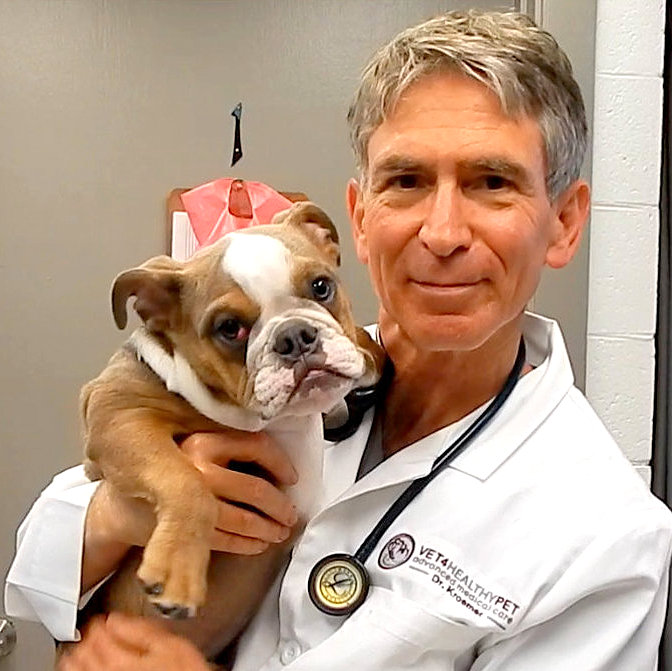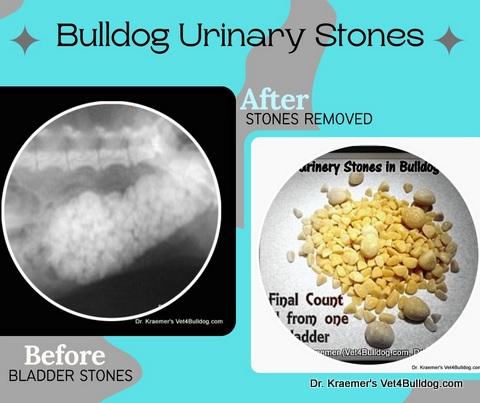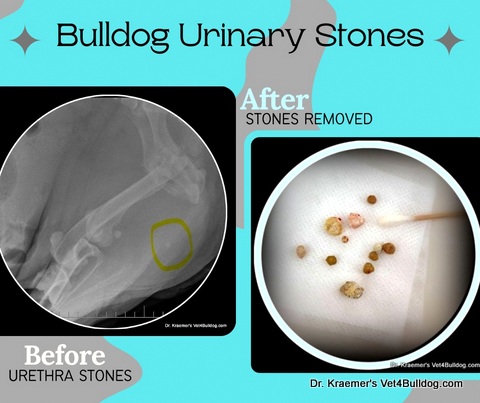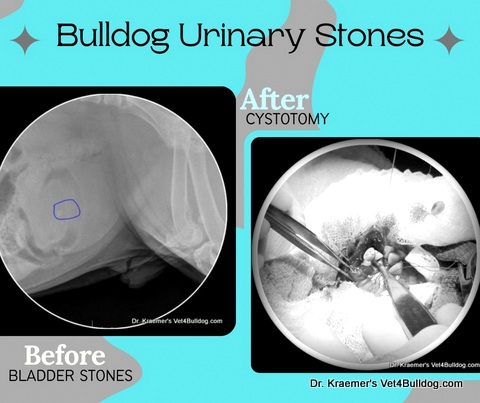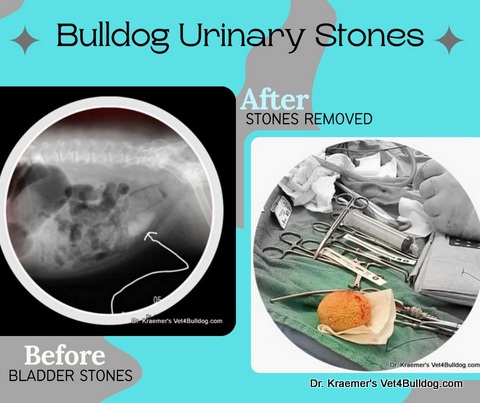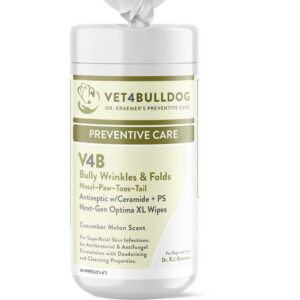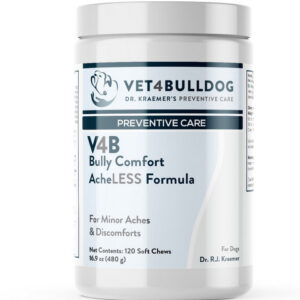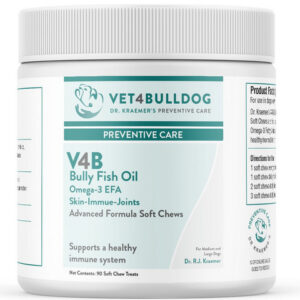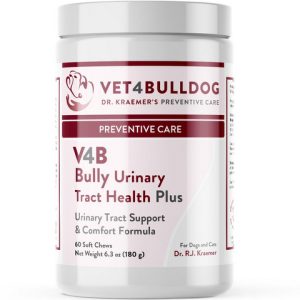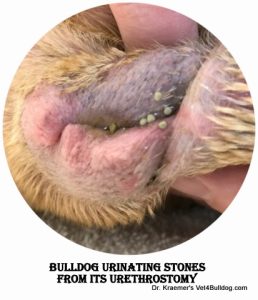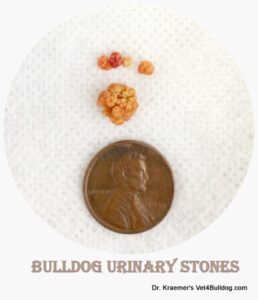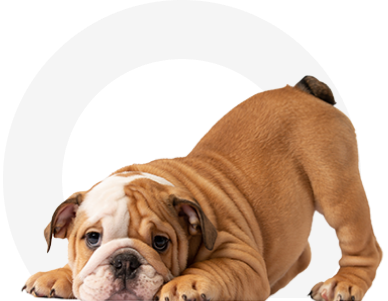Introduction to Urinary Stones In Bulldogs And French Bulldogs
Urinary stones can be a significant health issue for bulldogs and French bulldogs. These stones are essentially hard, crystal-like formations that develop in the urinary tract and include
Other names for urinary stones are calculi and Uroliths:
What Is The Urinary Tract?
The urinary tract is a vital system responsible for filtering waste and maintaining fluid balance in the body. It includes the following structures:
- Kidneys – Two bean-shaped organs that filter toxins, waste products, and excess fluid from the bloodstream to produce urine.
- Ureters – Narrow tubes that carry urine from each kidney down to the bladder.
- Bladder – A muscular storage sac that holds urine until it’s time to eliminate it.
- Urethra – The final passageway that allows urine to exit the body during urination.
When mineral crystals accumulate and harden within this system, urinary stones (uroliths) can form.
Their impact on a dog’s health depends on:
- Size – Larger stones can obstruct urine flow or irritate the bladder lining.
- Location – Stones may form in the kidneys, bladder, or urethra, and symptoms vary accordingly.
- Underlying cause – Factors such as infection, genetics, diet, or metabolic disease all influence the type and recurrence risk of stones.
Urinary Stones in Bulldogs and French Bulldogs TYPE:
Listed below are some of the stone types found in the breed, their commonality, and their origin.
1. BULLDOG STRUVITE URINARY STONES:
Struvite stones are often linked to urinary tract infections (UTIs).
They occur more frequently in female bulldogs, especially those with vaginal fold dermatitis or a hooded vulva, which predispose them to infections.
- Commonality: Less frequent in bulldogs compared to metabolic stones, but still seen.
- Origin: Infection-driven (urease-producing bacteria).
- Clinical Notes: They can grow to a considerable size and may cause pain, recurrent infections, or urinary blockages.
2. BULLDOG CALCIUM OXALATE URINARY STONES:
These stones tend to form in the bladder and are influenced by
- diet
- urine acidity
- calcium metabolism
- and sometimes underlying endocrine disorders such as Cushing’s disease or parathyroid abnormalities.
They can be differentiated from other stones by their unique:
- Commonality: Not very common in bulldogs.
- Origin: Metabolic and dietary factors, sometimes genetic.
- Clinical Notes: More common in other breeds, but bulldogs can still be affected.
3. BULLDOG URATE URINARY STONES:
Unlike most breeds, bulldogs are genetically predisposed to urate stone formation due to a defect in purine metabolism.
- Commonality: Relatively common in bulldogs, but rare in most other breeds.
- Origin: Genetic/metabolic.
- Clinical Notes: These stones are challenging to prevent and manage, often requiring specialized diets and ongoing medical care.
4. BULLDOG CYSTINE URINARY STONES:
Cystine stones result from a hereditary defect that causes excessive cystine (an amino acid) to spill into the urine.
- Commonality: Rare in most dogs but seen more frequently in bulldogs.
- Origin: Genetic.
- Clinical Notes: Cystine stones, like urate stones, have a high recurrence rate even with preventive measures.
Understanding the type of stone is critical for effective treatment and long-term prevention.
While struvite stones are infection-driven, urate and cystine stones are genetically based and particularly relevant in bulldogs.
What Causes Urinary Stones in Bulldogs and French Bulldogs?
- DIET: such as diets with excess minerals and proteins, diets impacting urine PH, and diets impacting hydration.
- WATER: A lack of water can lead to mineral/crystal oversaturation, which will speed up stone formation.
- GENETICS: Urate and Cystine Stones in bulldogs have genetic origins.
- INFECTION: Bacterial infections can lead to urinary stones (Struvite).
- CONGENITAL DEFECTS: such as ectopic ureter, and kidney dysplasia.
- METABOLIC DISEASE: such as excess calcium, as in the case of parathyroid gland disease.
What Are The Symptoms of Urinary Stones in Bulldogs and Fr. Bulldogs?
- INCONTINENCE: pee accidents.
- FREQUENCY: frequent urination.
- STRAIN: painful straining when voiding.
- BLOOD: hematuria, blood in the urine, red urine.
- THICK, DISTENDED ABDOMEN, UNABLE TO PEE: in the event of complete blockage (more common to male bulldogs).
- INABILITY TO URINATE: in the event of a full blockage, that will rapidly lead to a distended, painful abdomen and a critical illness.
Bladder Stones in Bulldogs and Fr. Bulldog DIAGNOSIS:
- URINE ANALYSIS: including urine PH, white blood cells, bacteria, crystals, etc.
- URINE CULTURE: bacteria type and ideal antibiotics.
- BLOOD TEST: kidney function and blood count, etc.
- IMAGING: radiographs & ultrasounds are the most common.
- STONE ANALYSIS: tests that determine the stone type.
How To Prevent Urinary Stones in Bulldogs?
- Genetic Testing
- Neutering: androgen-responsive case (cystine)
- Sufficient water
- Annual urine analysis
- Annual radiograph or ultrasound
- Bully Urinary Health Supplement
- Female proper vaginal hygiene with Bully skinfold Antiseptic wipes
How To Treat Urinary Stones in Bulldogs and French Bulldogs?
- RX DIET: Depending on the stone type, diet helps to reduce offensive minerals or proteins, and improve PH and hydration.
- WATER: Proper hydration helps to dilute the urine and prevent supersaturating.
- ANTIBIOTICS: when a bacterial infection is detected.
- PAIN RX: analgesics to manage pain.
- ANTI-INFLAMMATORY: Anti-inflammatories such as NSAIDs
BULLDOG THERAPEUTIC URINARY SUPPLEMENTS TREATMENT:
Supplements can be grouped by
#1 PAIN RELIEF:
like Dr. Kraemer’s V4B Bully Comfort Formula
#2 ANTI-INFLAMMATORY:
EFA Omega 3 and Glucosamine, like Dr. Kraemer’sV4B Bully Fish Oil and V4B Bully Advanced Total Joint
#3 ANTI-BACTERIAL:
Like Dr. Kraemer’s V4B Bully Urinary Support, which helps to reduce multi-drug resistance and biofilms.
#4 TOPICALS (Bully Antiseptic Wipes):
For female bulldog’s proper hygiene and UTI prevention, clean the virginal fold with antiseptic wipes, such as Dr. Kraemer’s V4B Bully Antiseptic XL Skin Fold Wipes.
OTHER URINARY STONE THERAEPUTICS:
Bulldog Urinary Stones Surgical Removal
Surgical options depend on
- gender
- stone size
- health status
- stone location
- stone type
- stone history
#1 Bulldog Urinary Stone Cystotomy
A cystotomy is a surgical procedure that provides direct access to the bladder for the removal of urinary stones (uroliths).
It is most commonly performed to:
- Remove bladder stones.
- Retrieve urethral stones that have been gently pushed back into the bladder for safer extraction.
A cystotomy allows for complete removal of stones, relief of discomfort, and prevention of further urinary complications.
#2 Bulldog Urinary Stone Urethrotomy
A urethrotomy is a surgical procedure in which an incision is made directly into the urethra to remove stones that have become lodged and are causing an obstruction.
This intervention can provide immediate relief by restoring urine flow and alleviating discomfort.
However, similar to a cystotomy, a urethrotomy does not address the underlying cause of stone formation. As a result, there remains a risk that new stones may form and migrate into the urethra, leading to future blockages.
Because of this recurrence risk, long-term management often requires a combination of
- dietary changes
- medical therapy
- and preventive monitoring to reduce the chances of stones re-forming.
#3 Bulldog Urinary Stone Urethrostomy
A urethrostomy is a surgical procedure used to create a new, permanent urinary opening in male dogs.
It is most often considered for patients with recurrent urethral obstructions that cannot be managed through less invasive means.
The surgery is usually performed at the scrotal region, where the urethra is naturally wider in diameter. This anatomical advantage allows urine, and any future stones that may develop to pass more freely, thereby reducing the risk of recurrent blockages.
By providing a permanent outlet, scrotal urethrostomy can significantly improve quality of life in male bulldogs prone to urinary stones.
However, it is generally regarded as a salvage procedure, reserved for cases where other surgical or medical options have failed or where obstruction is a recurring, life-threatening problem.
#4 Bulldog and French Bulldogs Urinary Stone Vaginoplasty:
Female Bulldogs and French Bulldogs are prone to recurrent urinary stones (such as struvite stones) when chronic urinary tract infections (UTIs) are present. Two common contributing factors are vaginal skinfold dermatitis and a hooded vulva, both of which create a moist, poorly ventilated environment that encourages bacterial growth.
A vaginoplasty is a corrective surgical procedure designed to reshape and open the vaginal folds and hood. By improving air circulation and reducing trapped moisture, this surgery helps alleviate dermatitis and significantly lowers the risk of recurring UTIs. In turn, this can decrease the likelihood of infection-induced stone formation.
For female Bulldogs experiencing these chronic issues, vaginoplasty can provide both comfort and preventive health benefits, making it an important consideration in the overall management of urinary health.
Urinary Stones in Bulldogs and French Bulldogs TIPS & WARNINGS
Below are selected urinary stone tips and warnings, courtesy of Dr. Kraemer
#1 URINARY STONES WATER TIP:
Drinking sufficient water will help with normal urination and prevent supersaturation and stone formation.
To help improve the water intake, mix low-salt broth with water, make ice cubes, and add one daily to your bulldog’s water dish.
#2 BULLDOG BLADDER STONES CANNED FOOD TIP:
Canned food has more moisture than dry food, which will help in the same manner as above by increasing water intake.
#3 URINARY STONES RX DIETS TIP:
Adhere to your veterinarian’s recommendations for stone dissolution and prevention.
#4 URINARY FEMALE HYGIENE TIP:
Many female bulldogs suffer from vaginal fold dermatitis. Proper daily hygiene with wipes, like Dr. Kraemer’s V4B Bully Antiseptic XL Skinfold Wipes can help prevent urinary tract problems.
#5 URINARY STONES IMAGING TIP:
Your bully might exhibit the same clinical signs as a stone or UTI. Therefore, I recommend that you take radiographs and/or an ultrasound of your bully’s abdomen, in addition to urine, to help rule out urethral, bladder, ureter, and/or kidney stones.
BULLDOG CULTURE & SENSITIVITY:
Urine analysis is not adequate for ruling out bacterial infections (UTI).
A culture and antibiotic sensitivity test should be combined with it to determine the bacteria type and best antibiotic combination.
#1 URINARY STONES BACTERIA RESISTANCE WARNING:
Bacteria can defend themselves by adhering to your bulldog’s bladder wall and forming a biofilm. There are various natural supplements, such as extracts, like Dr. Kraemer’s V4B Bully Urinary Support Formula can help prevent resistance and help antibiotics with the elimination of resistant bugs.
#2 BULLDOG EMERGENCY BLOCKAGE & URETEROSTOMY:
Suppose your male dog was diagnosed with stones in the bladder and/or urethra.
In that case, you should consider a permanent urethrostomy instead of just a cystotomy (opening the bladder) and/or a urethrotomy (opening the urethra).
A urethrostomy provides for a permanent “stoma” (opening), usually at the scrotal area
A urethrotomy is just a temporary opening to allow the stone to be removed.
#3 BULLDOG URINARY STONE RECURRENCE WARNING:
Unfortunately, urinary stones in Bulldogs have a high rate of recurrence, even when owners follow strict preventive measures. This recurrence poses a significant risk of re-blockage, which may require another round of anesthesia and emergency surgery.
Too often, veterinarians either do not fully explain this risk to their clients or underestimate how likely recurrence is in this breed.
In my own experience, I have seen many Bulldogs develop new stones shortly after their initial stone removal surgery.
For some families, the financial and emotional burden of a second surgery or an unexpected emergency can be overwhelming. Sadly, this has led some owners to make the heartbreaking decision of surrendering their dogs to rescue organizations when treatment becomes unmanageable.
Because of this, it is important that veterinarians discuss all surgical options upfront, including combining a permanent urethrostomy with the initial stone removal.
While urethrostomy is typically considered a salvage procedure, offering it at the time of first surgery can, in select cases, prevent future blockages and reduce the need for repeated emergency interventions.
#4 BULLDOG URINARY STONE REMOVAL SURGEON WARNING:
It’s essential to entrust this procedure to a qualified professional to minimize potential complications and ensure the best outcome for your pet, common complications are strictures and bleeding.
#5 STONE REMOVAL BLEEDING WARNING
Following the surgery, it’s normal to observe some bleeding from the surgical site. In some cases, this bleeding may require medical attention, which could involve hospitalization and sedation for your bulldog.
Bulldog and French Bulldog URETHROSTOMY FINAL NOTE:
In my practice, I have performed numerous urethrostomy surgeries on Bulldogs suffering from recurrent urinary stones despite prior stone removal procedures. The results have been overwhelmingly positive—all patients recovered well and were able to return to normal activity without significant complications.
Bulldogs tend to adapt quickly to urinating through the new opening. While some may experience minor accidents during the initial adjustment period, most owners report that their dogs soon establish normal urination habits. In fact, it is not uncommon for owners to observe stones passing naturally during urination after surgery. Should a minor obstruction occur, it can often be easily relieved by flushing.
Overall, urethrostomy has proven to be a highly effective solution for Bulldogs with recurring stone issues. By reducing the risk of life-threatening blockages and eliminating the need for repeated emergency surgeries, this procedure significantly improves both the dog’s comfort and quality of life.
Urinary Stones in Bulldogs and Fr. Bulldogs MONITORING:
- optimal PH
- crystals
- infection
Recommended by Owners Approved by Bulldogs



